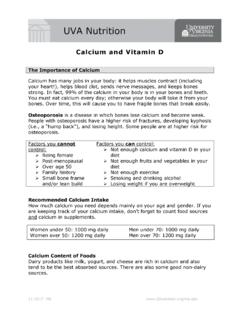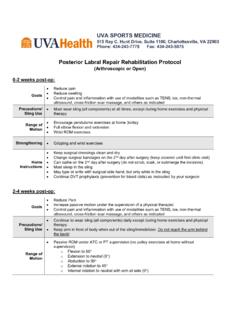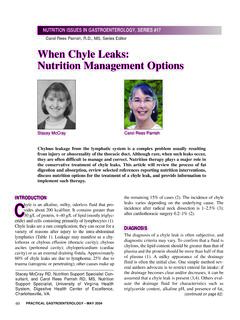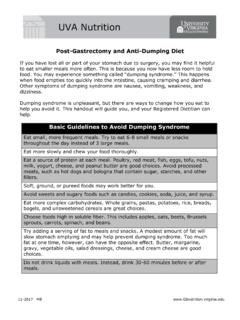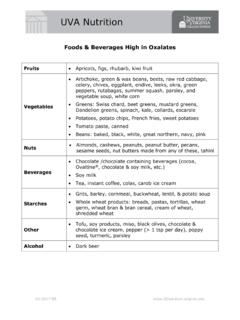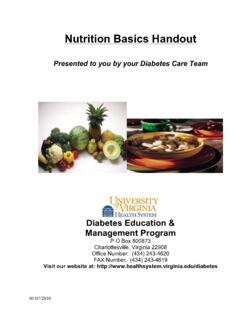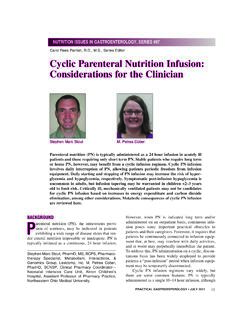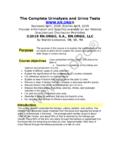Transcription of Nutrition Intervention for the Patient with Gastroparesis ...
1 Nutrition ISSUES IN GASTROENTEROLOGY, SERIES #30. Carol Rees Parrish, RD, MS, Series Editor Nutrition Intervention for the Patient with Gastroparesis : An Update Carol Rees Parrish Cynthia M. Yoshida Gastroparesis , or delayed gastric emptying, has many origins. The clinical presentation may wax and wane depending on the underlying etiology. However, once a Patient develops protracted nausea and vomiting, providing adequate Nutrition , hydration and access to therapeutics such as prokinetics and antiemetics can present a unique chal- lenge to clinicians. This article provides suggested guidelines to assess the nutritional status of patients with Gastroparesis and strategies to treat the nutritional issues that arise in this Patient population. INTRODUCTION ics and antiemetics can present a unique challenge to valuation of nutritional status and the treatment of clinicians.
2 E malnutrition are important factors in the manage- ment of patients with Gastroparesis . Symptoms of Gastroparesis (Table 1) may be severely debilitating Gastroparesis has many origins and its clinical pre- sentation may wax and wane depending on the under- lying etiology (see Table 2 for conditions associated with Gastroparesis ). Many patients (and some clini- and the resultant aberrations in nutritional status can be life threatening. Once a Patient develops protracted cians) assume that a diagnosis of Gastroparesis means nausea and vomiting, providing adequate Nutrition , continuous clinical deterioration until an end-stage is hydration and access to therapeutics such as prokinet- reached. Research to date, however, supports that early Nutrition support can reverse significant malnutrition while gastric function returns over time.
3 In truth, many Carol Rees Parrish , , Nutrition Support Specialist, University of Virginia Health System, patients with refractory Gastroparesis who initially Digestive Health Center of Excellence, Charlottesville, require jejunal feeding tube placement for Nutrition M. Yoshida, , Gastroenterologist, support often eventually eat again on their own (1 5). Charlottesville, VA. (continued on page 33). PRACTICAL GASTROENTEROLOGY AUGUST 2005 29. Nutrition Intervention for the Patient with Gastroparesis : An Update Nutrition ISSUES IN GASTROENTEROLOGY, SERIES #30. (continued from page 29). Table 1 Table 2. Clinical Symptoms of Gastroparesis Clinical Conditions Associated with Gastroparesis (53,54). Decreased appetite / anorexia Mechanical obstruction Nausea and vomiting Duodenal ulcer Bloating Pancreatic carcinoma or pseudocyst Fullness (especially in the morning after an overnight fast) Gastric carcinoma Early satiety Superior mesenteric artery syndrome Halitosis Post-prandial hypoglycemia, or fluctuating glucose levels in Metabolic/endocrine disorders an otherwise well-controlled Patient with diabetes mellitus Diabetes Mellitus Hypothyroidism Used with permission from the University of Virginia Health System Hyperthyroidism Nutrition Support Traineeship Syllabus (31) Hyperparathyroidism Adrenal insufficiency (Addison's disease).
4 Although prokinetic agents and antiemetics are Acid-peptic disease Gastric ulcer front line therapy in the treatment of Gastroparesis (6), Gastroesophageal reflux disease the purpose of this article is to provide strategies to maintain or restore nutritional status in this Patient Gastritis population. There is a scarcity of clinical trials in the Atrophic gastritis area of Nutrition Intervention for patients with gastro- Viral gastroenteritis paresis. Review articles and textbooks are available, Post-gastric surgery however, evidence-based Nutrition recommendations Vagotomy are lacking. Most of the current dietary guidelines and Antrectomy restrictions have been developed from studies evaluat- Subtotal gastrectomy ing the effect of a single parameter on gastric empty- Roux-en-y gastrojejunostomy ing in normal subjects (7).
5 Fundoplication This article provides practical guidelines to assess Disorders of gastric smooth muscle the nutritional status of patients with Gastroparesis and Scleroderma strategies to treat nutritional issues that arise in this Polymyositis Patient population. More detailed reviews of all facets Muscular dystrophy of Gastroparesis are available elsewhere (8,9). Amyloidosis Chronic idiopathic pseudoobstruction Dermatomyositis Systemic lupus erythematosus (SLE). Nutrition ASSESSMENT. The purpose of nutritional screening and evaluation in Psychogenic disorders the Patient with Gastroparesis is to objectively distin- Anorexia guish the adequately nourished Patient who can pursue Bulimia Depression further gastrointestinal (GI) evaluation and/or proki- netic trials, from a malnourished Patient who requires Neuropathic disorders immediate nutritional support.
6 Parkinson's disease Paraneoplastic syndrome CNS disorders Weight Change Over Time High cervical cord lesions (C4 and above). Unintentional weight loss over time is probably the most important, noninvasive parameter to assess over- all nutritional status in the Patient with Gastroparesis . PRACTICAL GASTROENTEROLOGY AUGUST 2005 33. Nutrition Intervention for the Patient with Gastroparesis : An Update Nutrition ISSUES IN GASTROENTEROLOGY, SERIES #30. Table 3. loss, and therefore the severity of malnutrition. Evaluation of Weight Change Over Time Another essential principle is to assure that the Patient 's actual weight represents a euvolemic weight, neither % Weight Change = Usual Weight Actual Weight* ( 100) dehydrated, nor edematous. As an example, a Patient Usual Weight with diabetes mellitus (DM) who presents with vomit- ing, diarrhea and poor glucose control may have a Significant Severe falsely low actual weight due to dehydration.
7 Failure to Malnutrition Malnutrition use a euvolemic actual weight might overestimate the 1 week 1% 2% >2% amount of weight loss over time and suggest signifi- 1 month 5% >5%. cant malnutrition instead of the fact that the Patient is 3 months > 6 months 10% >10% merely dehydrated. Finally, it is also imperative to remember that those patients who are clinically over- *Compare the Patient 's UBW to their euvolemic current actual weight. weight or obese, yet have unintentionally lost a signif- Adapted from Shopbell JM, Hopkins B, Shronts EP. Nutrition screening icant amount of weight over a short time interval, may and assessment. In: Gottschlich M, ed. The Science and Practice of Nutri- tion Support: A Case-Based Core Curriculum. Dubuque, IA: Kendall/Hunt carry the same risk profile as a chronically undernour- Publishing Company, 2001:119, with permission from the American ished Patient .
8 Society for Parenteral and Enteral Nutrition ( ). does The time course of weight loss is also important. not endorse the use of this material in any form other than its entirety. Table 3 demonstrates that both a 2% loss over 1 week and a 10% loss over 6 months both constitutes severe When an accurate weight can be obtained, this para- malnutrition, which is associated with increased mor- meter is a simple, reliable indicator of nutritional sta- bidity and mortality (10). Beware of the hemodialysis tus. An unintentional loss of usual body weight Patient who experiences serial drops in their target over a three-month period signals significant malnutri- weight over time; 50% of patients on dialysis are a tion and should be a cause for concern. result of long-standing DM, which is commonly asso- It is important to compare a Patient 's current ciated with Gastroparesis .
9 Actual weight (AW) to their usual body weight Although unintentional weight loss over time is the (UBW) to determine nutritional risk and/or whether best indicator of the severity of malnutrition, some significant weight loss has occurred. To compare the investigators utilize weight alone as a measure of a Patient 's actual weight to an ideal body weight might Patient 's nutritional status. Patients may be deemed mal- either grossly over- or underestimate the true weight (continued on page 39). Table 4. Risk of Associated Disease According to BMI and Waist Size Waist less than or equal to Waist greater than BMI* Category 40 in. (men) or 35 in. (women) 40 in. (men) or 35 in. (women). or less Underweight - N/A. Normal - N/A. Overweight Increased High Obese High Very High Obese Very High Very High 40 or greater Extremely Obese Extremely High Extremely High *These values may underestimate the degree of malnutrition in some patients.
10 An overweight or obese Patient may be malnourished if significant weight loss has occurred, but not fall into the category of malnutrition based on BMI alone. Obtained from (Accessed 7-1-05). 34 PRACTICAL GASTROENTEROLOGY AUGUST 2005. Nutrition Intervention for the Patient with Gastroparesis : An Update Nutrition ISSUES IN GASTROENTEROLOGY, SERIES #30. (continued from page 34). nourished based on a stable weight below normal, loss Table 5. of an arbitrary amount of weight, or loss of a significant Medications Known to Delay Gastric Emptying (6,53). percentage of baseline weight. Commonly, ideal body weight for an individual is determined based on weight Aluminum-containing L-dopa relative to height. The Body Mass Index (BMI) is deter- antacids Lithium Anticholinergics Octreotide mined as weight (kg)/ height (m)2 (see Table 4 or go to: Atropine Ondansetron ) (11).

